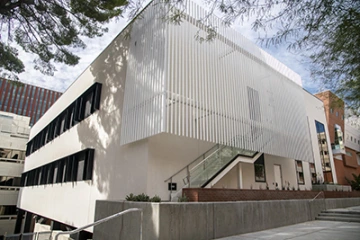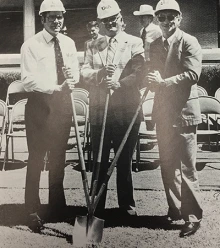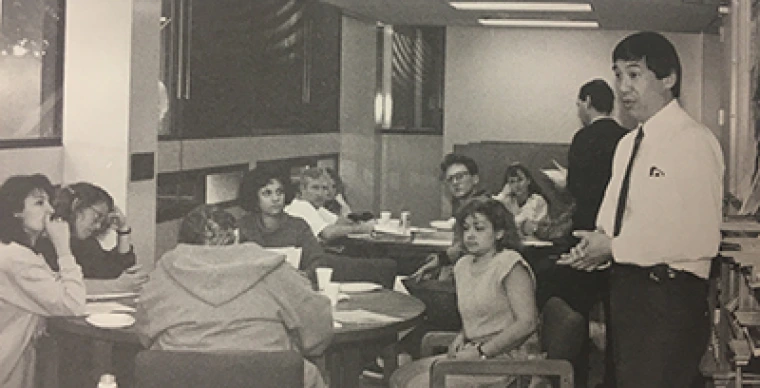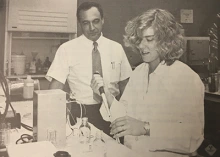New Laboratories in Skaggs Center’s Expansion Will Enhance Education, Enable New Drug Discovery and Usher in “An Era of Transformation”
The expanded and renovated Skaggs Center will become a new home for the Arizona Center for Drug Discovery, new chemistry and biology laboratories, and the History of Pharmacy Museum expansion.
The University of Arizona Health Sciences’ institutional commitment to reshape the future of pharmaceutical training and research took another step forward Feb. 21 as the College of Pharmacy celebrated the grand opening of the expanded Skaggs Pharmaceutical Sciences Center in Tucson.

Renovated and expanded Skaggs Center, 2020.
University of Arizona President Robert C. Robbins, MD, Health Sciences Senior Vice President Michael D. Dake, MD, University of Arizona Foundation President John-Paul Roczniak, and Dean of the College of Pharmacy Rick Schnellmann, PhD, spoke at the event and lauded the tools the space provides to talented professionals and driven students.
Investing in Health Innovation
“With the addition of this state-of-the-art education and research space, we have enhanced our ability to recruit the best and brightest faculty and students, and we are in a stronger position to achieve remarkable results in improving human health and potential in Arizona, across the country, and around the world,” Dr. Dake said.
In the 70 years since its inception, the College of Pharmacy has built a reputation for research in areas including anti-cancer drugs, new antibiotics and antidotes for poisoning.
Dr. Schnellmann said the new Skaggs will build on the College’s successes.

Pharmacy Dean Rick Schnellmann, PhD, in one of the new chemistry laboratories in the expanded Skaggs Center
With its new space in Skaggs, the Arizona Center for Drug Discovery aims to bring a differentiated infrastructure for drug discovery and catalyze investigations into new drug treatment options. The center will bolster interprofessional research and provide greater opportunity for cross-campus collaborations, including translating laboratory discoveries into commercializable opportunities.
The new chemistry and biology laboratories feature cutting-edge equipment for the synthesis, purification and identification of novel compounds. The laboratories will enhance the work of the Arizona Center for Drug Discovery, which supports UArizona Health Sciences investigators in their drug discovery research efforts, and serves as an alliance management and drug discovery strategy resource.
Expanding Education
Skaggs opened in 1982, and it was the first official building for the College. Since then, thousands of pharmacists and scientists have received their training and developed numerous advances in pharmaceutical research there.
“This expansion will allow the College of Pharmacy to remain on the forefront of drug discovery research.”
Pharmacy Dean Rick Schnellmann, PhD
The College is now educating more than 800 students, who are working toward degrees ranging from Bachelor of Science to Doctor of Pharmacy to PhD scientists. They can also earn specialized certificates and interdisciplinary degrees, such as the dual Doctor of Pharmacy and Master of Science in Nursing with Family Nurse Practitioner Certificate.
The expansion of the Skaggs building also features a 2,000-square-foot area dedicated to the History of Pharmacy Museum, which is set to open later this year.
Dr. Schnellmann said the renovation marks a turning point in achieving the College’s vision of improving interprofessional research, drug discovery and education.
“It heralds an era of transformation in our College’s history,” he said.
Some Things Have Changed
In the nearly 40 years since the Skaggs Pharmaceutical Science Center was built, the College and the profession have experienced many changes.
Research Focus
Then: In the late 1970s and early 1980s the College had a reputation as a center for pharmaceutical research in areas such as the development of anti-cancer drugs from plants and the study of the cause and treatment of epilepsy. Research was also concentrated on the synthesis of new antibiotics to treat infections as well as new drugs for the treatment of mental illness.
Now: The College of Pharmacy is focused in large part on academic drug discovery and development, as well as pharmaceutics, pharmacology and toxicology research. The mission of the Arizona Center for Drug Discovery, now housed in Skaggs, is to build a differentiated infrastructure for Drug Discovery to catalyze new drug treatment options for patients. It will do this in part by translating current research into the marketplace across disease areas, therapeutic modalities and target classes.
Interprofessional Collaboration

1982 ground breaking for the first iteration of the Skaggs Pharmaceutical Sciences Center with former University of Arizona President John Schaefer, former vice president of Skaggs Companies Arnold E. Ford, and former College of Pharmacy Dean Jack. R. Cole, PhD.
Then: Throughout most of the profession’s history, pharmacists were primarily seen as experts in medicines and so their work and educational experiences centered around solidifying that understanding.
Now: There is an ever-growing demand for multifaceted healthcare providers and pharmacists are stepping in to address the gaps, requiring new skills and interprofessional experience. For many in rural and medically underserved areas, pharmacists are the healthcare provider patients interact with most frequently and they are often asked to deliver medical advice in a variety of areas. Today’s pharmacy school graduates will not only work at retail and community pharmacies, they will also likely work in a setting where they provide direct patient care. The College’s programs have evolved with the industry to meet the needs of students and communities.
College of Pharmacy Student Body
Then: In 1982, approximately 220 students were enrolled at the College in the undergraduate, master’s degree, and PhD programs. Skaggs would soon become the main location for students to attend to attend class and participate in research labs.
Now: More than 830 students are enrolled in programs offered through the College of Pharmacy. Students continue to filter through the halls of the Skaggs Center to work in research labs and attend classes.
Programs Offered
Then: Up until 1982, the College of Pharmacy offered a variation of the now widely known Doctorate of Pharmacy. In addition to the doctorate programs, a Master of Science in alcohol studies was initiated in 1971. By 1980, new programs were developed, including clinical sciences, geriatrics, psychopharmacology and environmental toxicology. Starting in 1982, the College received approval to begin offering the Doctor of Pharmacy (PharmD) program, which is the same degree still offered today to all aspiring pharmacists.

College of Pharmacy students attend class in the Skaggs Pharmaceutical Sciences Center.
Now: Students interested in the study of pharmacy can customize their degree program to their interest, and can begin studying with the Bachelor of Science in Pharmaceutical Sciences program. In addition to the classic PharmD degree, the College offers dual degrees and certificates to expand professional skills and make students more marketable in a competitive job market. The College continues to offer a variety of master’s degree and PhD programs in drug discovery and research, pharmaceutics and pharmacokinetics, health and pharmaceutical outcomes, and pharmacology and toxicology.
Equipment Used

A researcher watches over a lab assistant in one of the original Skaggs Center laboratories.
Then: In 1982, researchers incorporated radioactive tracers and radioactive counting in their work. The Skaggs building housed the only mass spectrometer on the Health Sciences campus and the most concentrated chemical synthesis area. Most researchers were using manual techniques for their work. There was also a larger portion of animal studies before cell culture and molecular techniques came into use.
Now: Researchers in the College use state-of-the-art liquid chromatography-mass spectrometer systems for the analysis and detection of trace components, and the sophisticated use of nanoparticles drive the delivery of drugs, and further enhance developments in pharmacology and toxicology.

